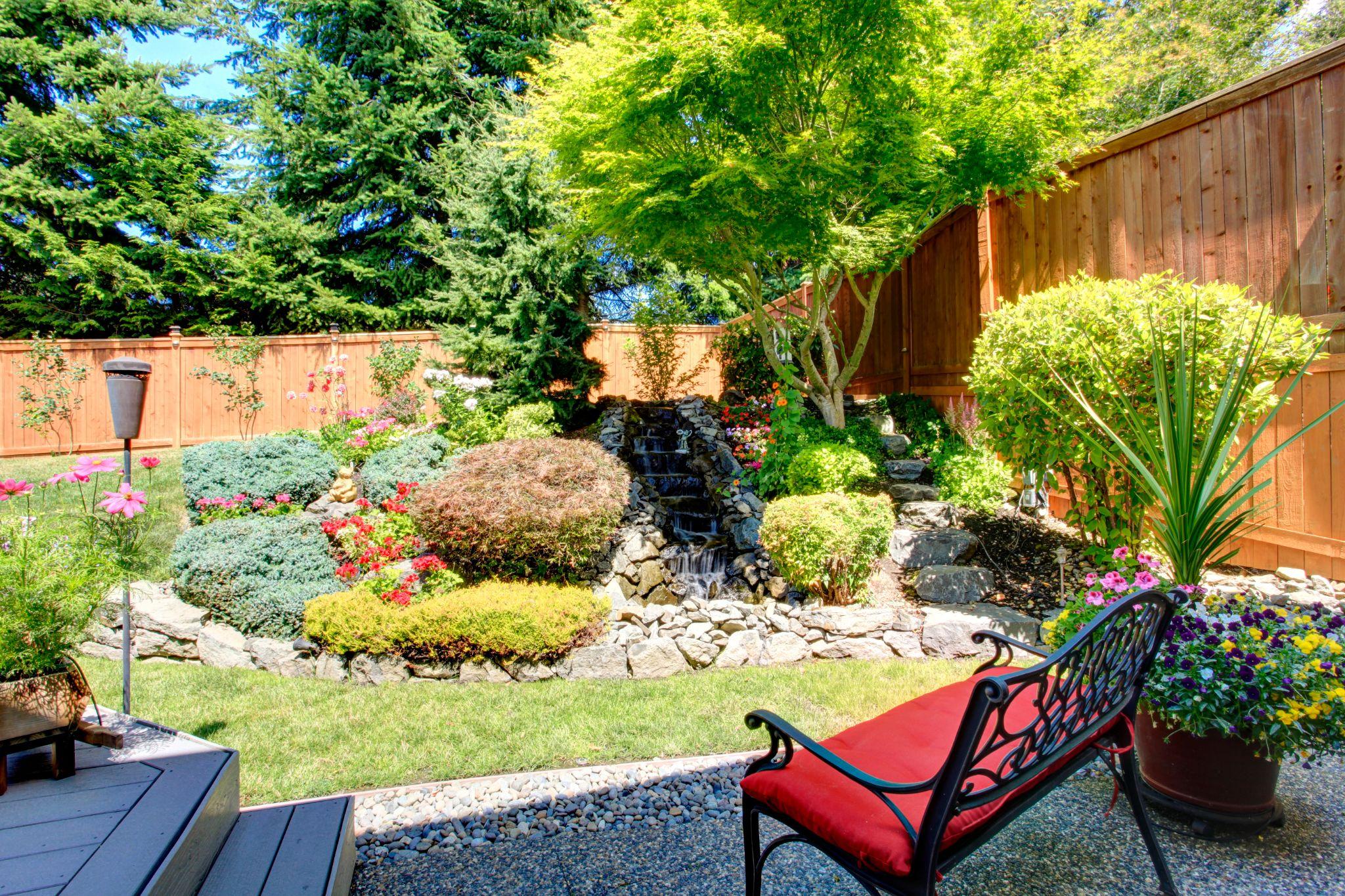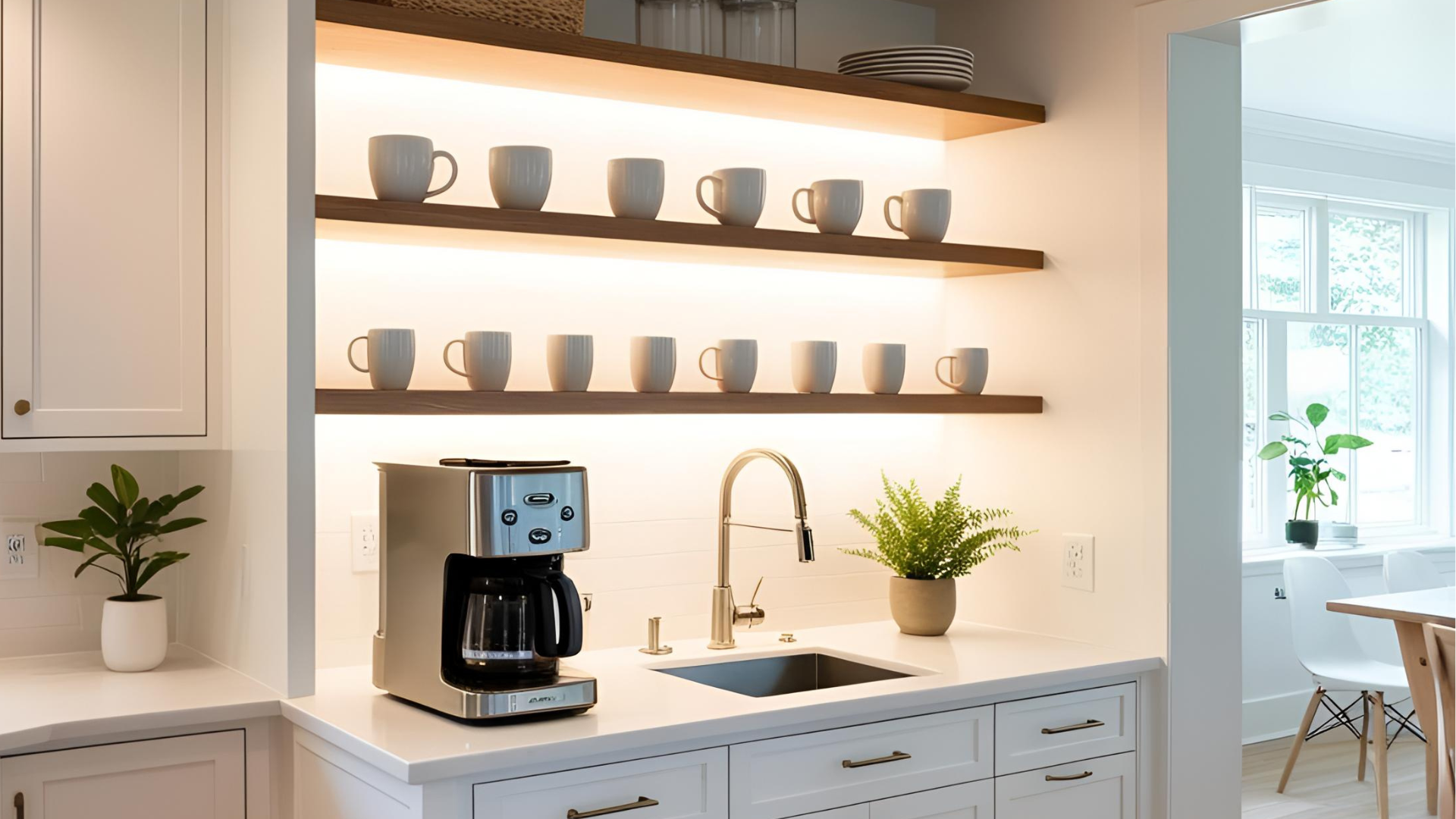Explore the Magic of Moroccan Colors in Design
I know how color can make or break a design. But finding the right palette can be tricky. That’s where Moroccan colors come in.
These vibrant hues have captivated me and other designers for centuries, bringing warmth and energy to any space.
I promise to show you how to use Moroccan colors in your designs. You’ll learn to create eye-catching spaces that feel both exotic and inviting.
In this post, I’ll explore the key colors in Moroccan design, share tips for using them effectively, and give you ideas for incorporating them into your projects.
Get ready to add some Moroccan magic to your design toolkit!
The Significance of Colors in Moroccan Culture
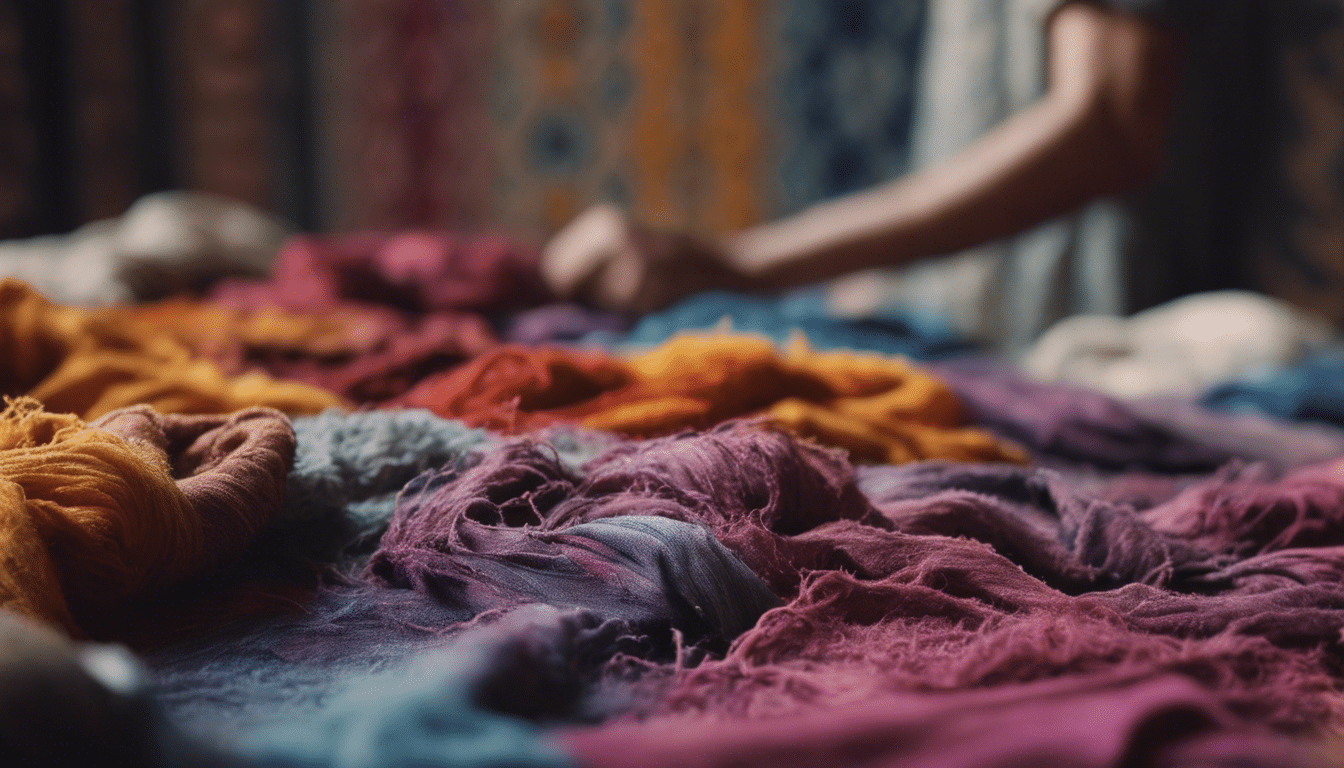
Colors play a big role in Moroccan culture. They’re not just pretty – each has a special meaning.
Let’s take a closer look at some key colors:
Red
This bold color is a big deal in Morocco. You’ll see it everywhere in Marrakech, which folks call the “Red City.”
Why? Many buildings there use red clay in their walls. In Moroccan culture, red stands for bravery and strength.
Blue
Blue is another star in Moroccan design. There’s even a famous shade called Majorelle Blue. It’s named after the French artist Jacques Majorelle, who used it extensively in his Moroccan garden.
You’ll spot this bright blue on buildings, tiles, and pottery.
Green
Green has a special place in Moroccan hearts. It’s tied to Islam, the main religion there. Look up when you’re in Morocco – you might see green roofs on mosques. Green means peace and hope to many Moroccans.
Yellow/Ochre
These warm colors remind people of the Sahara Desert. You’ll see them on walls of old buildings and in artwork. They bring a sunny, earthy feel to Moroccan spaces.
White and Black
These colors often complement Moroccan design. They can be found in patterns on floors and walls (called mosaics) and woven into fabrics.
White stands for purity, while black adds drama and depth.
Each of these colors helps tell Morocco’s story. When you use them in design, you’re not just making things look nice – you’re sharing a bit of Moroccan culture, too.
Popular Moroccan Color Palettes to Transform Your Home
1. Moroccan Colors with Jewel Tones
Sapphire Blue
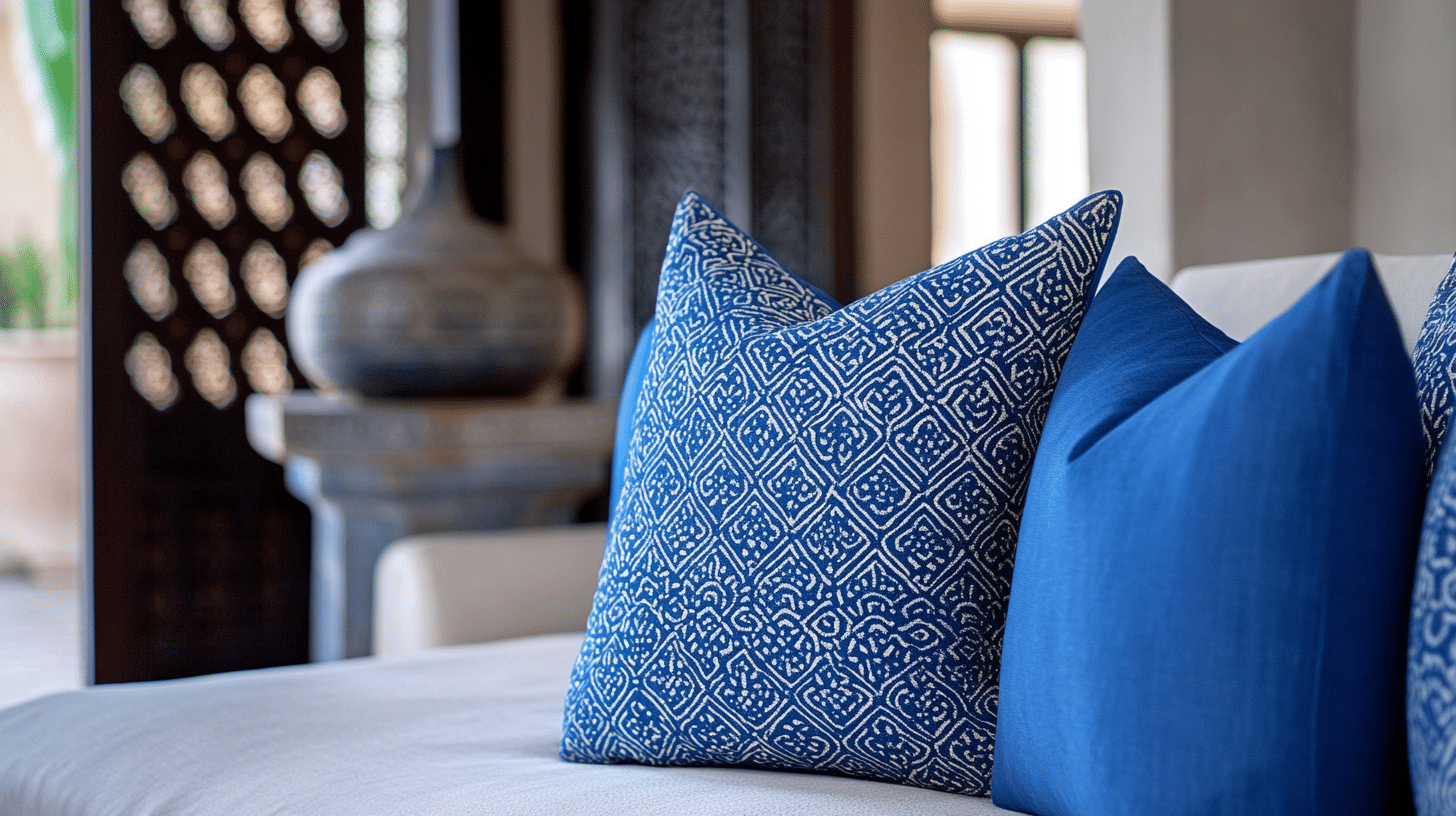
- Why Consider This Color Idea: Adds Richness and A Sense of Calm; Reminds You of The Ocean.
- Where to Use This Idea: Great for Living Rooms, Bedrooms, or Even the Bathroom for A Spa-Like Feel.
- How to Incorporate It: Use It in Rugs, Wall Paint, or Accent Pillows.
Emerald Green
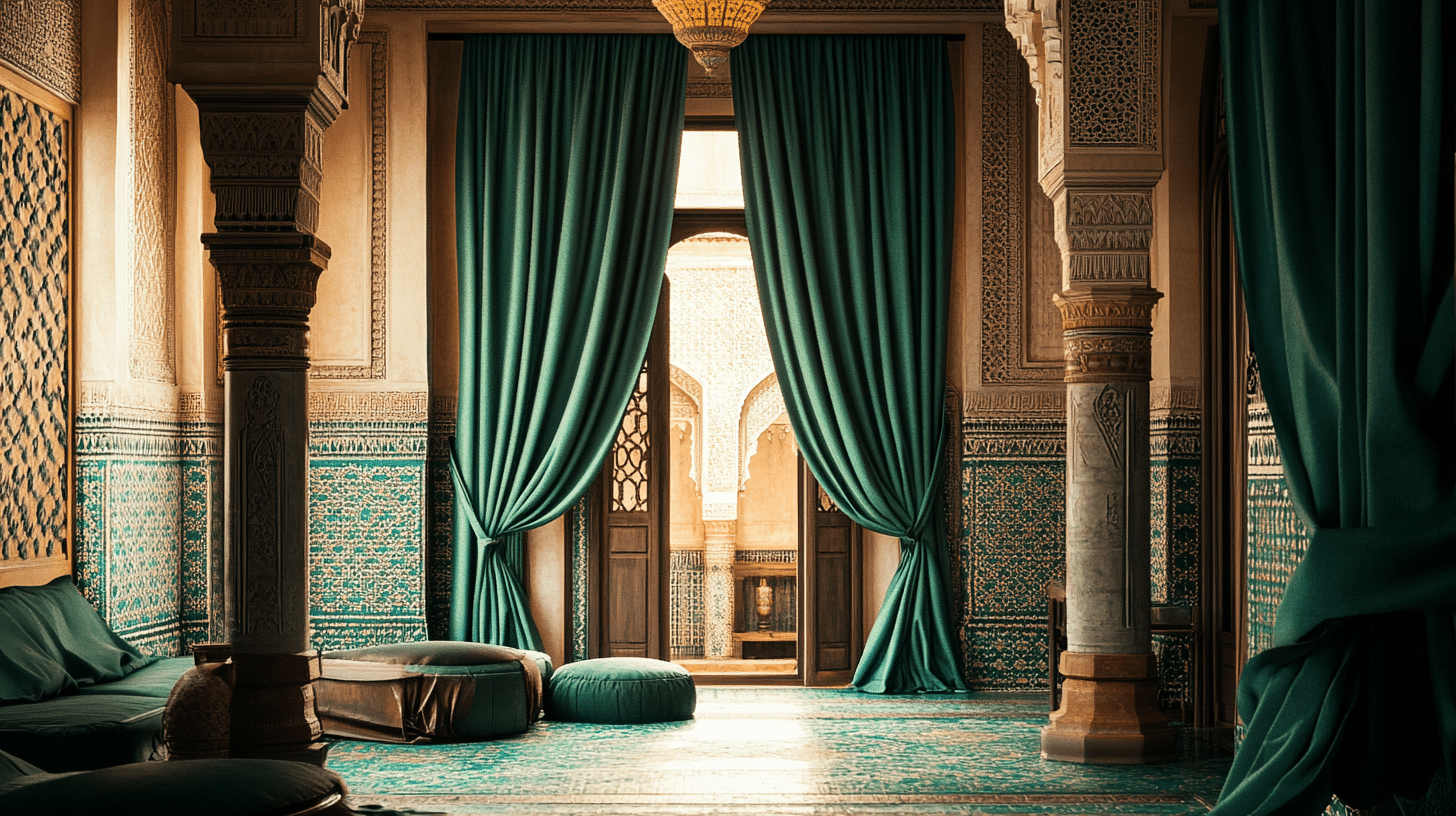
- Why Consider This Color Idea: Brings a Lush, Vibrant Touch that Feels Natural and Fresh.
- Where to Use This Idea: Ideal for Dining Areas, Living Rooms, and Garden Spaces.
- How to Incorporate It: Perfect for upholstery, curtains, or wall art.
Ruby Red
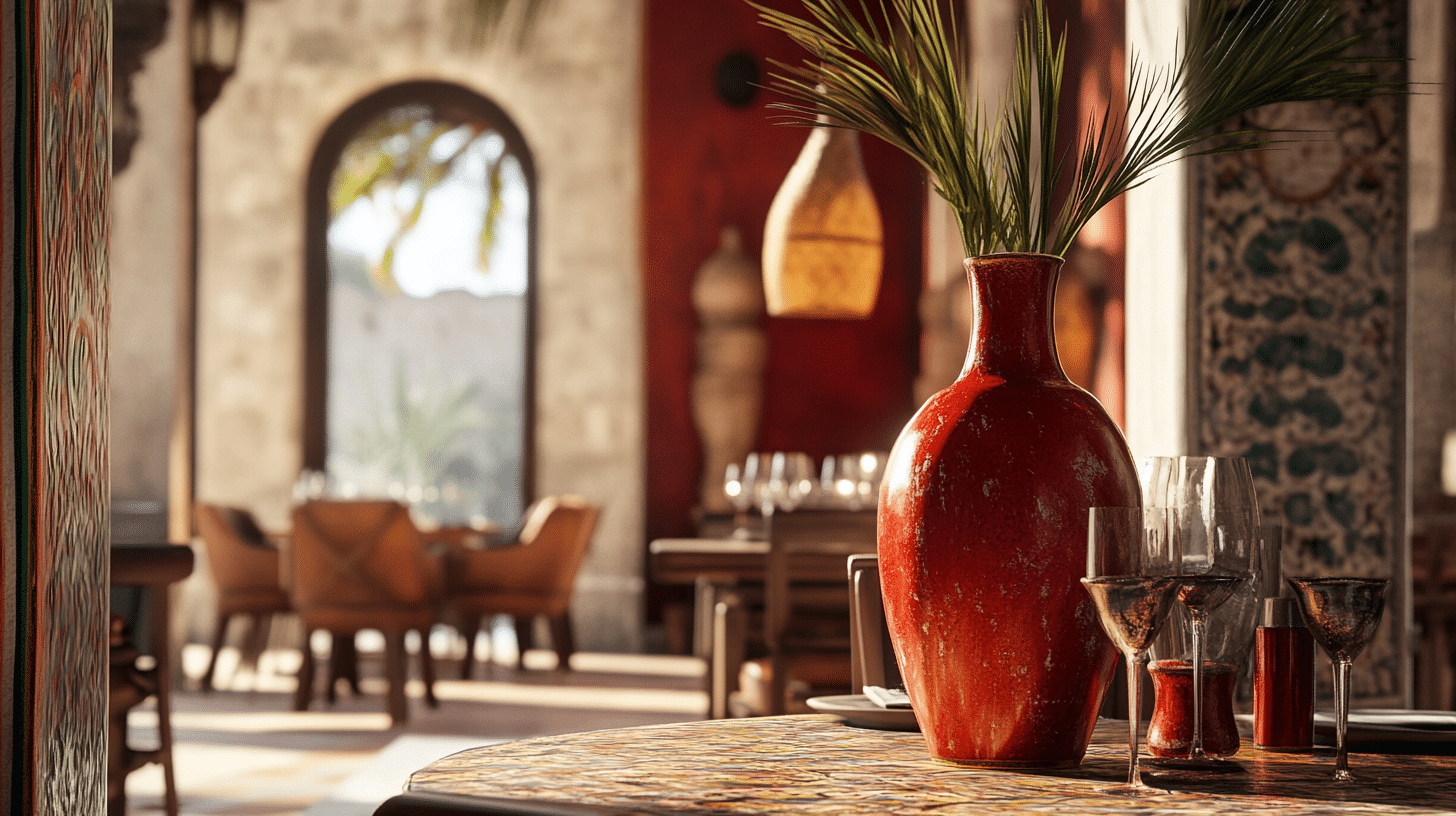
- Why Consider This Color Idea: Adds warmth and a touch of luxury; feels bold and inviting.
- Where to Use This Idea: Ideal for dining rooms, entryways, or accent walls.
- How to Incorporate It: Use in throw blankets, decorative vases, or as a feature wall color.
Amethyst Purple
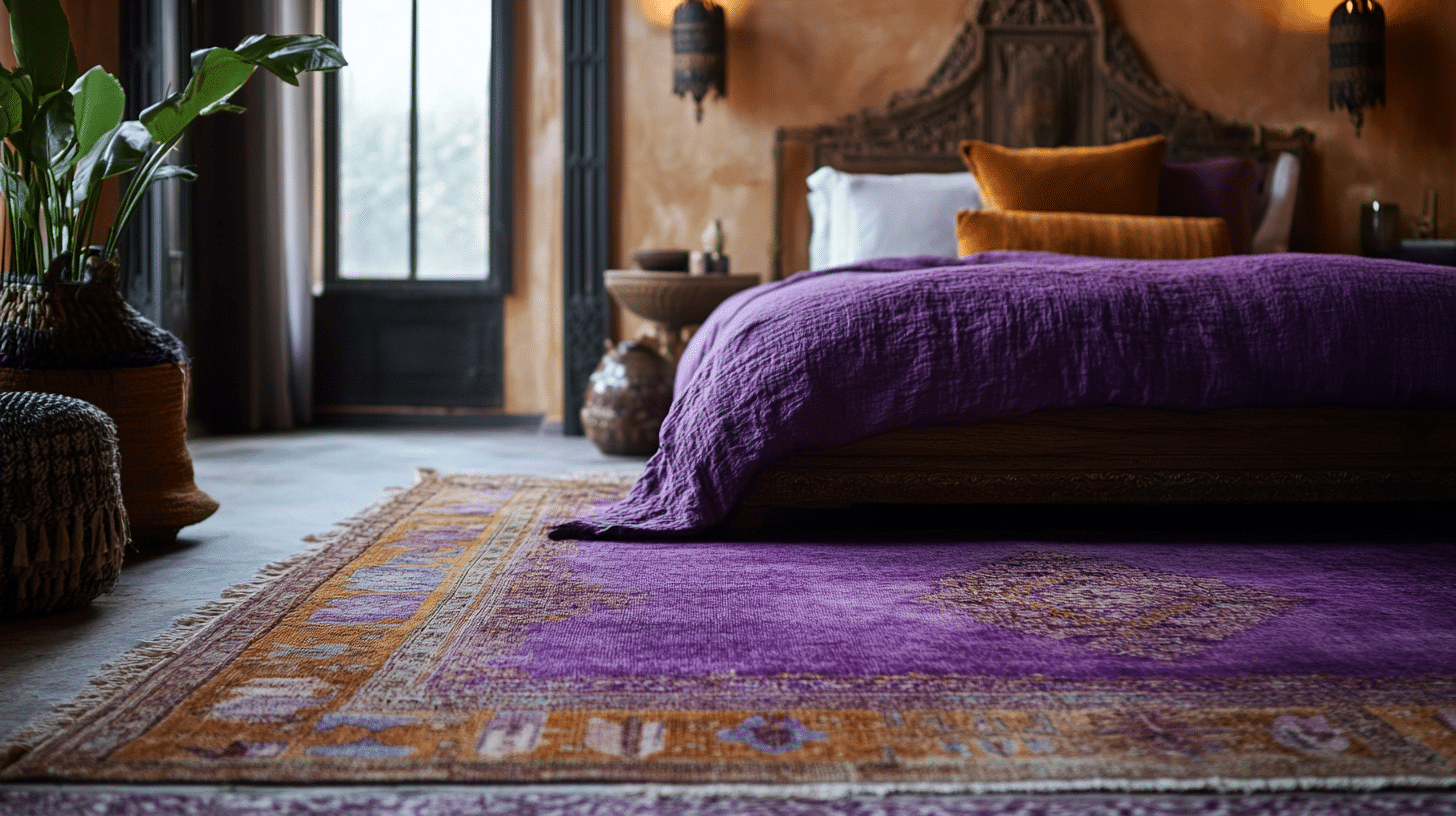
- Why Consider This Color Idea: Brings a cozy and calming vibe; perfect for creating a soft, welcoming space.
- Where to Use This Idea: Works well in bedrooms, reading nooks, or living areas.
- How to Incorporate It: Great for cushions, area rugs, or drapes.
Topaz Yellow
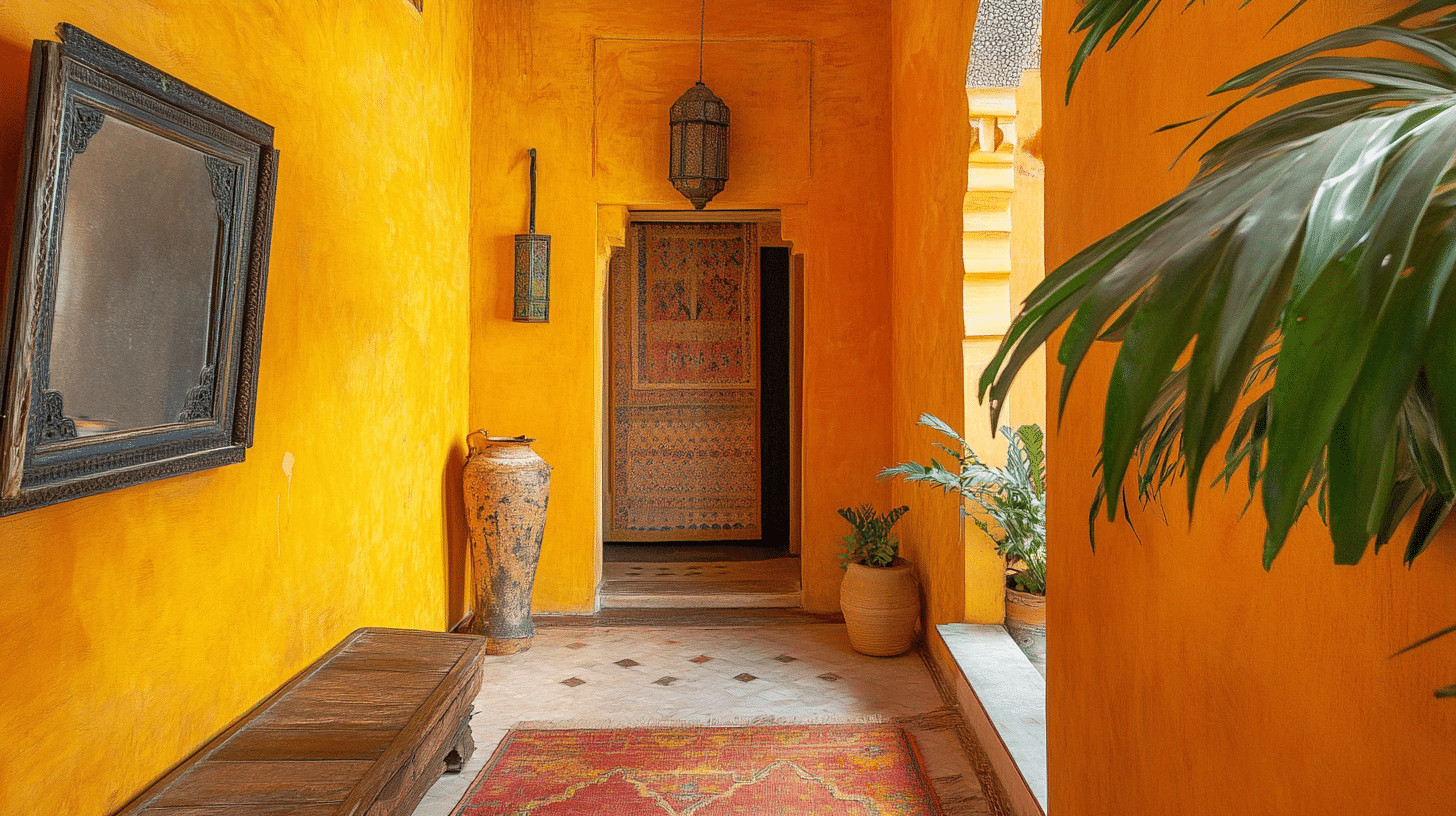
- Why Consider This Color Idea: Adds brightness and a cheerful touch; brings warmth to any room.
- Where to Use This Idea: Perfect for kitchens, hallways, and kids’ rooms.
- How to Incorporate It: Try it in wall art, light fixtures, or as accent decor.
2. Moroccan Colors with Earthy Tones
Burnt Orange
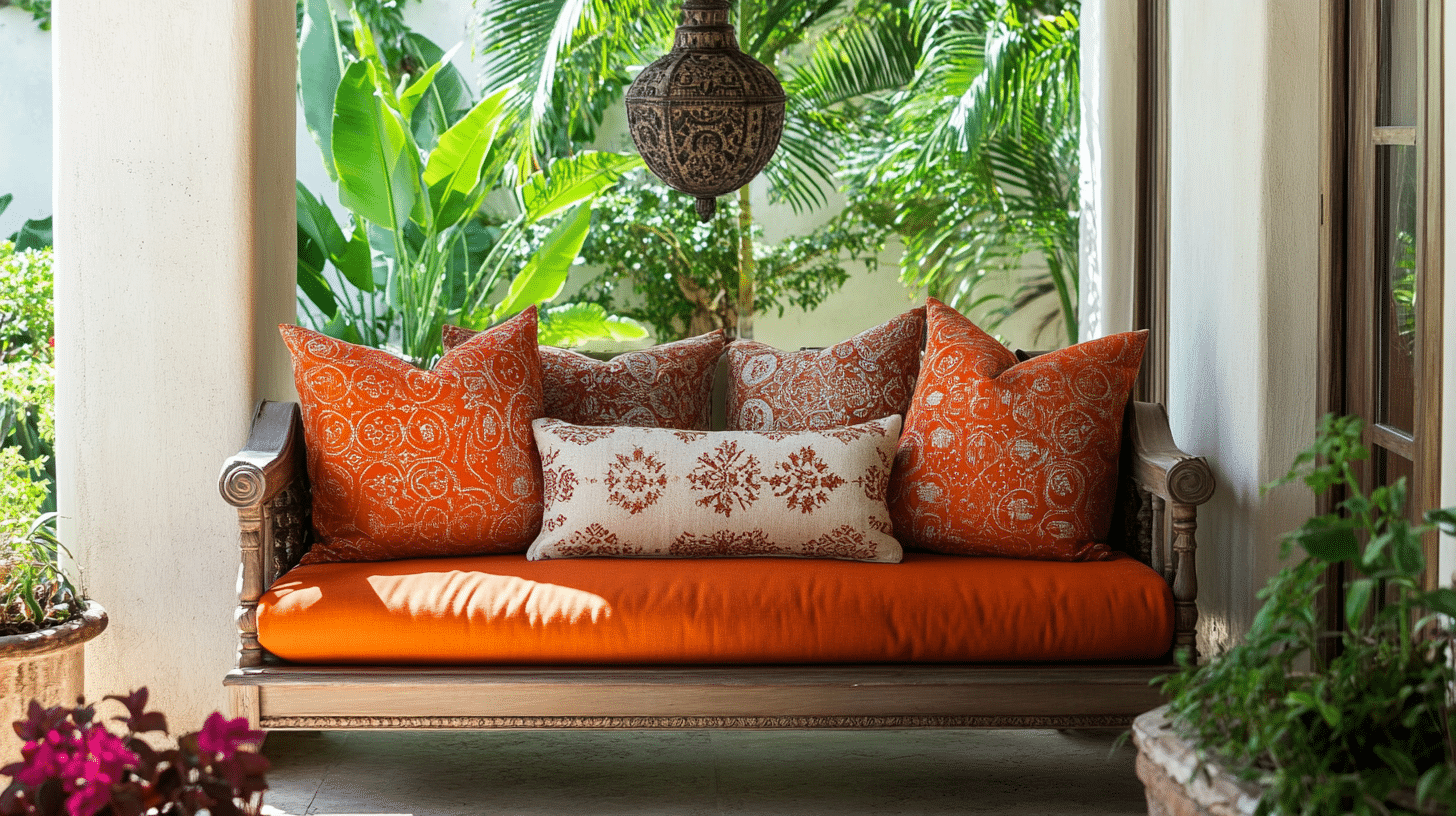
- Why Consider This Color Idea: Brings warmth and a cozy feel; reminds you of clay and sun-baked earth.
- Where to Use This Idea: Ideal for living rooms, dining areas, and outdoor patios.
- How to Incorporate It: Use it in throw pillows, terracotta planters, or accent walls.
Olive Green
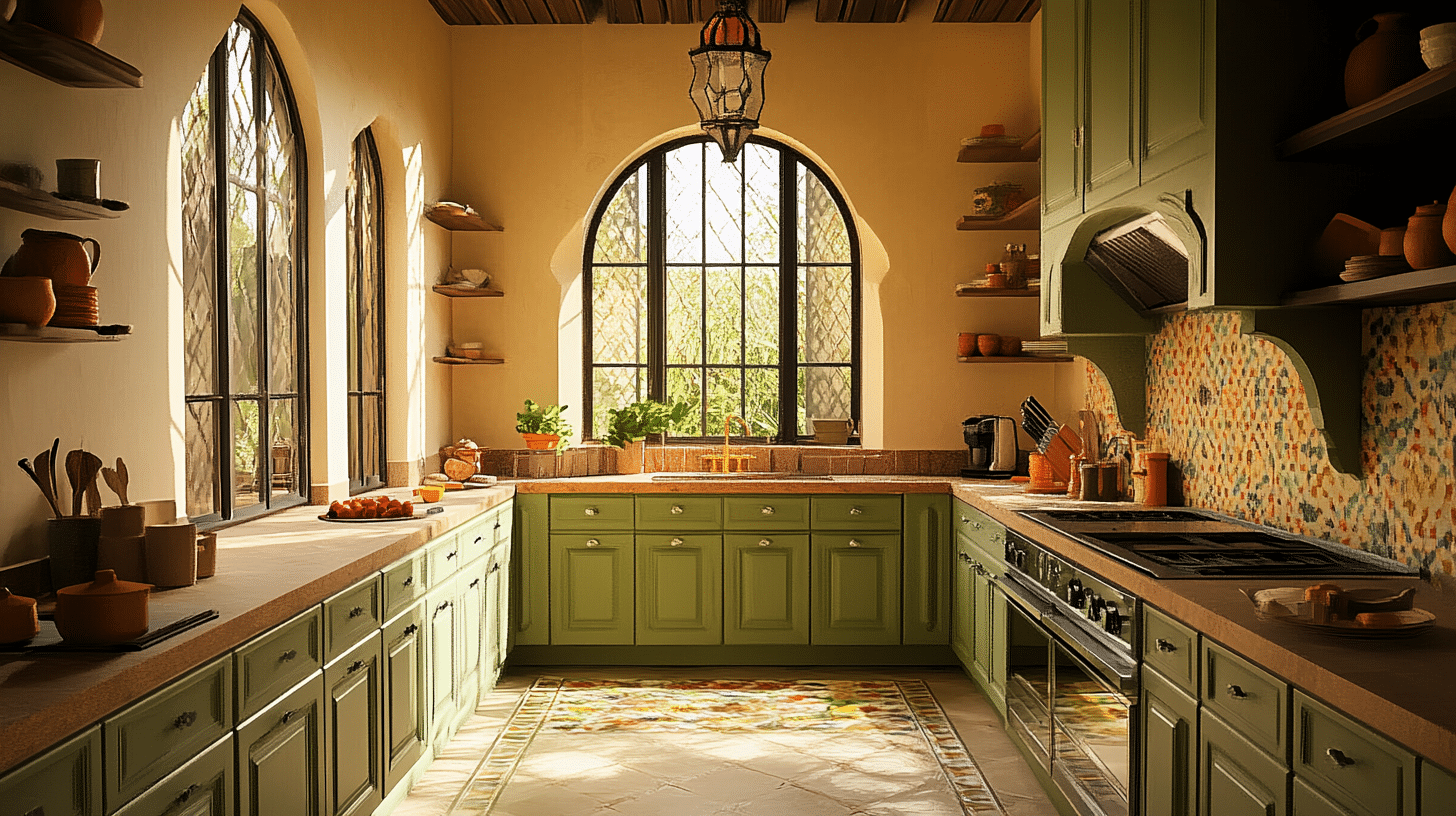
- Why Consider This Color Idea: Adds a natural, earthy vibe that feels peaceful and grounded.
- Where to Use This Idea: Perfect for kitchens, entryways, and bedrooms.
- How to Incorporate It: Try it in cabinetry, bedding, or wall accents.
Desert Sand
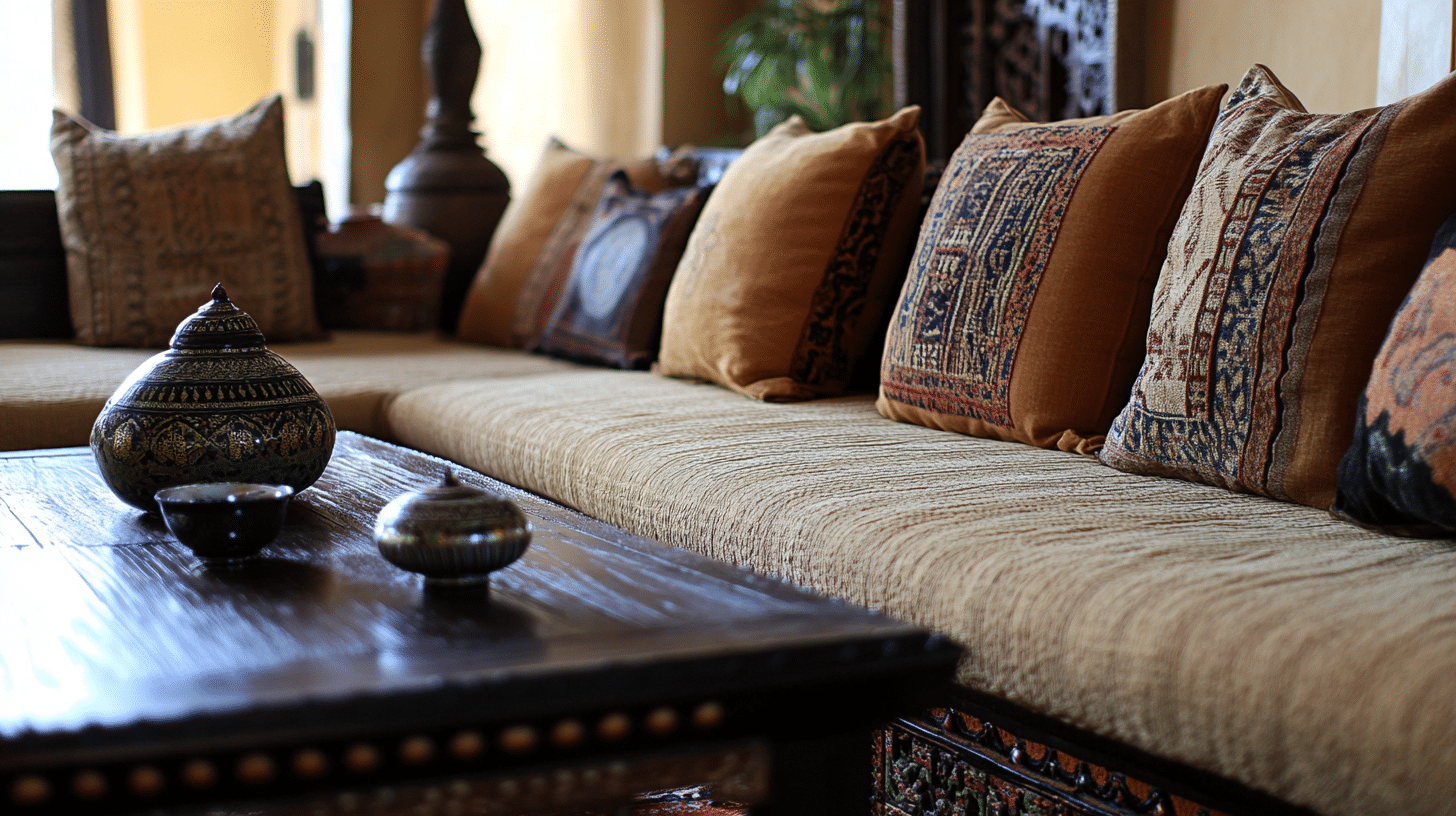
- Why Consider This Color Idea: Neutral and calming; creates a light and airy atmosphere.
- Where to Use This Idea: Works well in bathrooms, hallways, and living spaces.
- How to Incorporate It: Use in rugs, wall paint, or upholstery.
Umber Brown
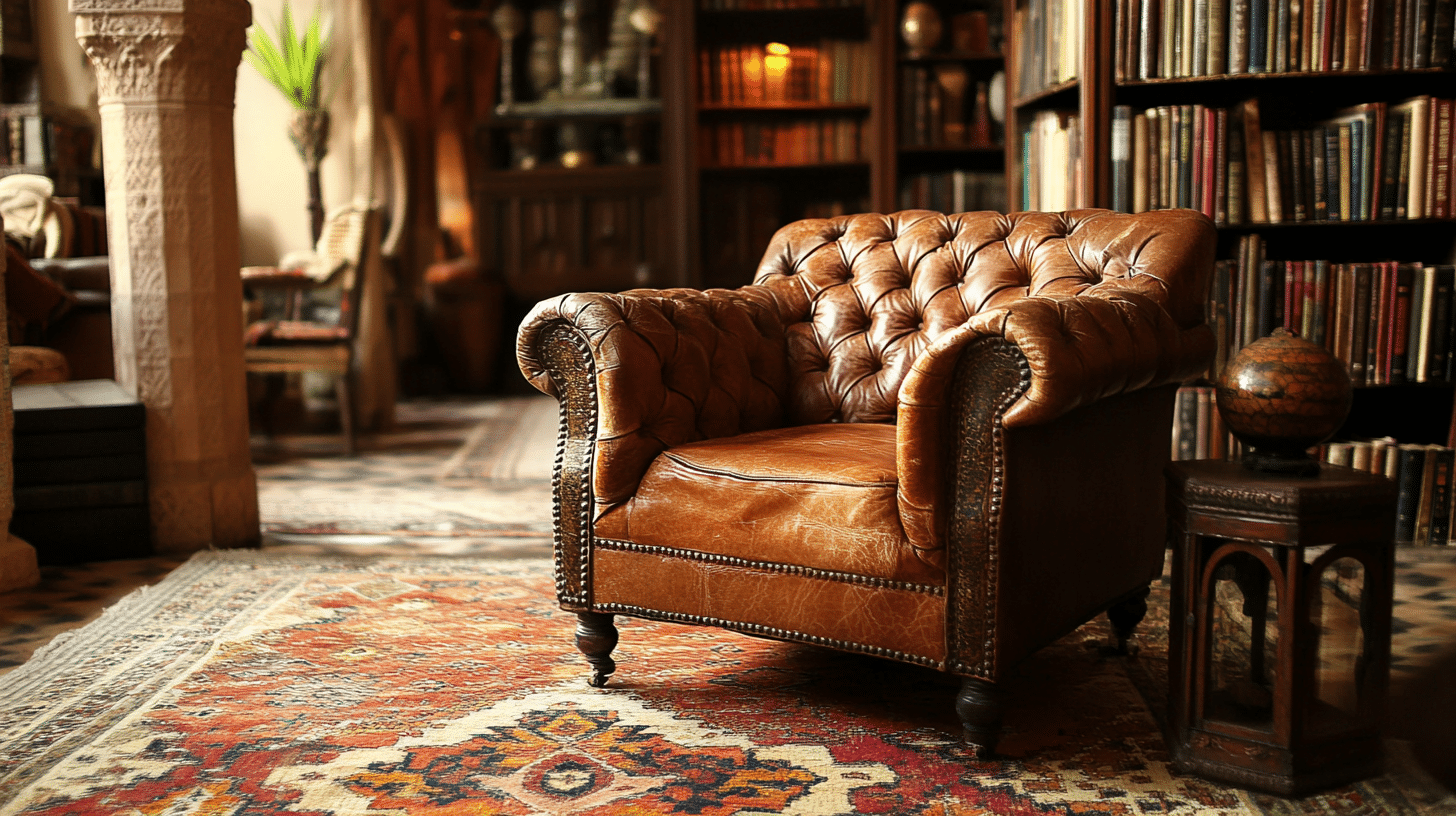
- Why Consider This Color Idea: Adds depth and warmth; gives rooms a rich, grounded look.
- Where to Use This Idea: Great for offices, libraries, and cozy nooks.
- How to Incorporate It: Incorporate leather furniture, wood finishes, or as a feature wall.
Ochre Yellow
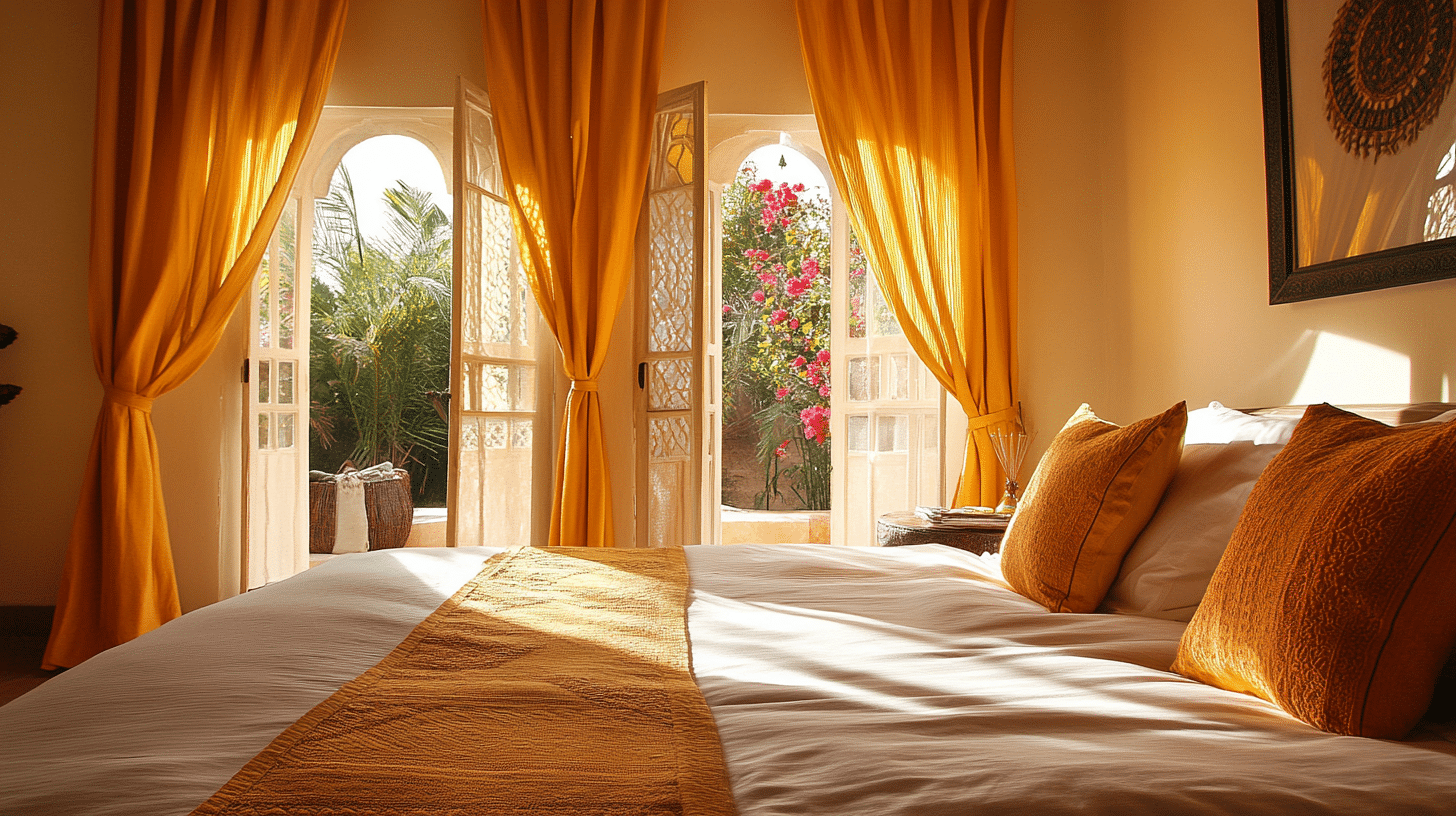
- Why Consider This Color Idea: Warm and inviting; adds a subtle hint of color without overpowering.
- Where to Use This Idea: Ideal for kitchens, bedrooms, and accent pieces.
- How to Incorporate It: Use in curtains, pottery, or painted decor.
Moroccan Color Palettes Contrast Ideas That I Love
Cobalt Blue & Tangerine Orange
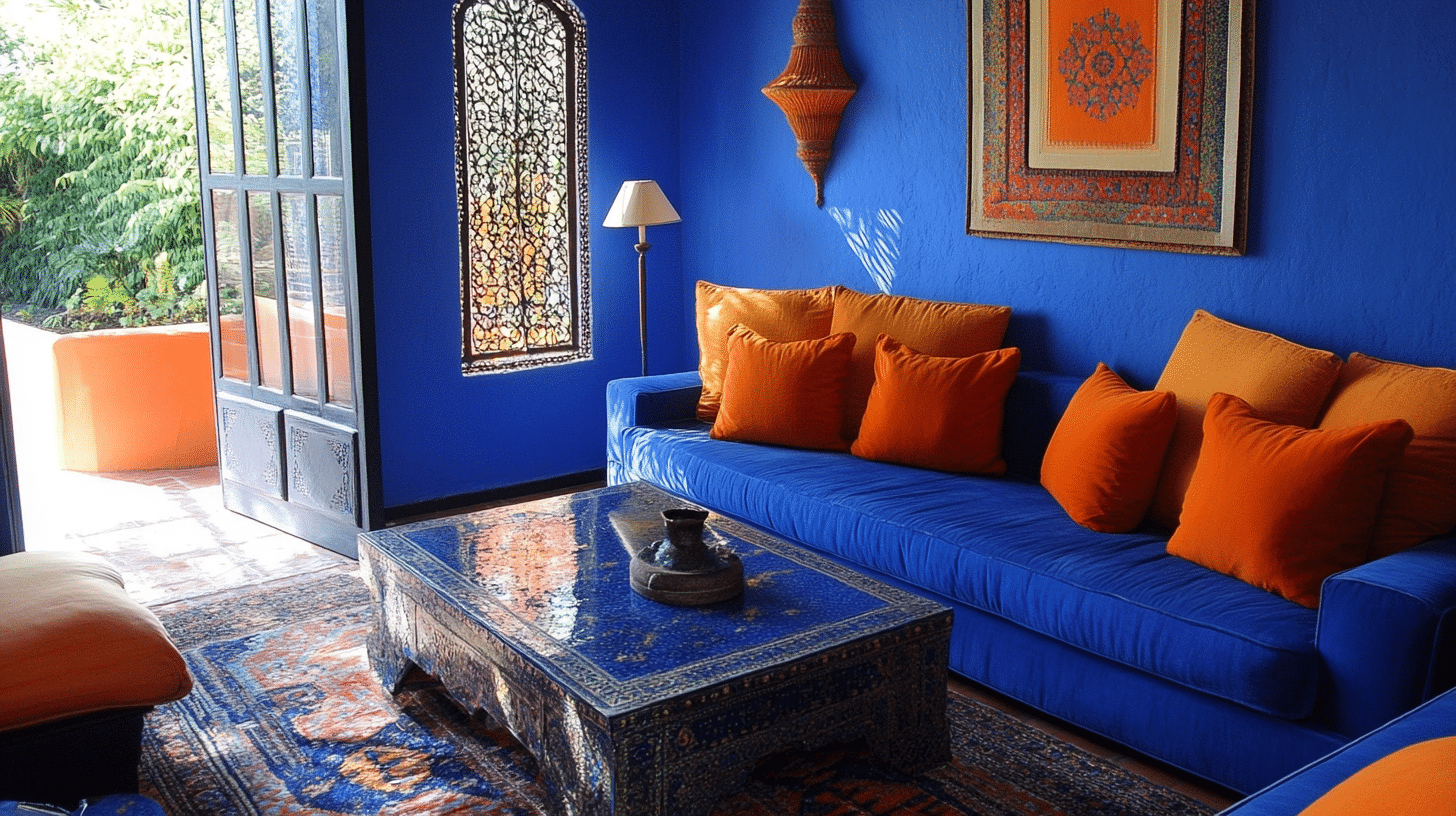
This combo packs a punch! The deep, cool blue next to the warm, zesty orange creates a look that’s hard to ignore—like the sky meeting the sunset.
Try using this pair in throw pillows or a feature wall in your living room.
Fuchsia Pink & Lemon Yellow
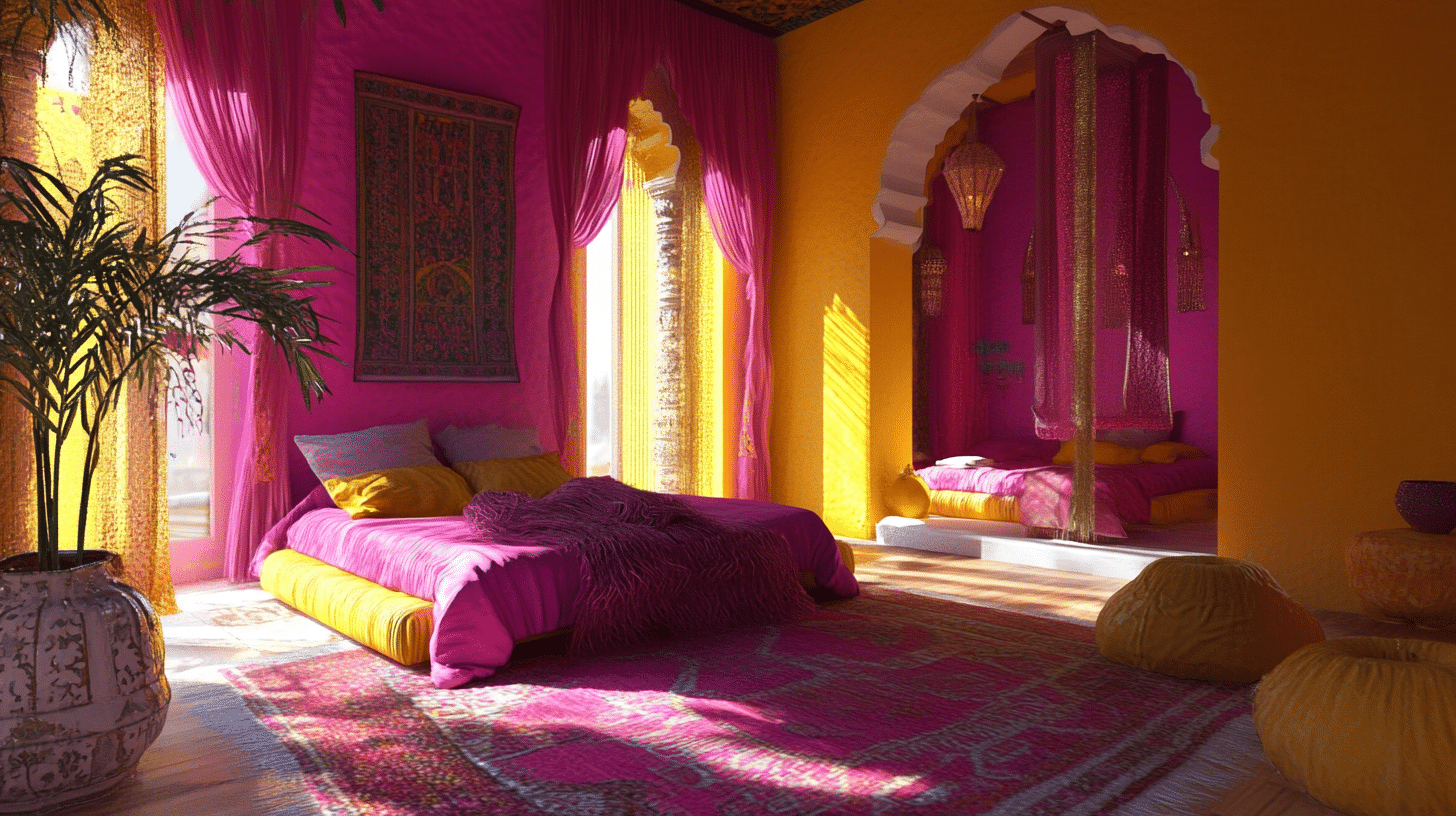
Talk about a happy duo! The bright pink and sunny yellow together make a room feel alive and cheerful—like a burst of flower power.
This lively pair works great as accent pieces in a bedroom or kitchen accessories.
Turquoise & Coral
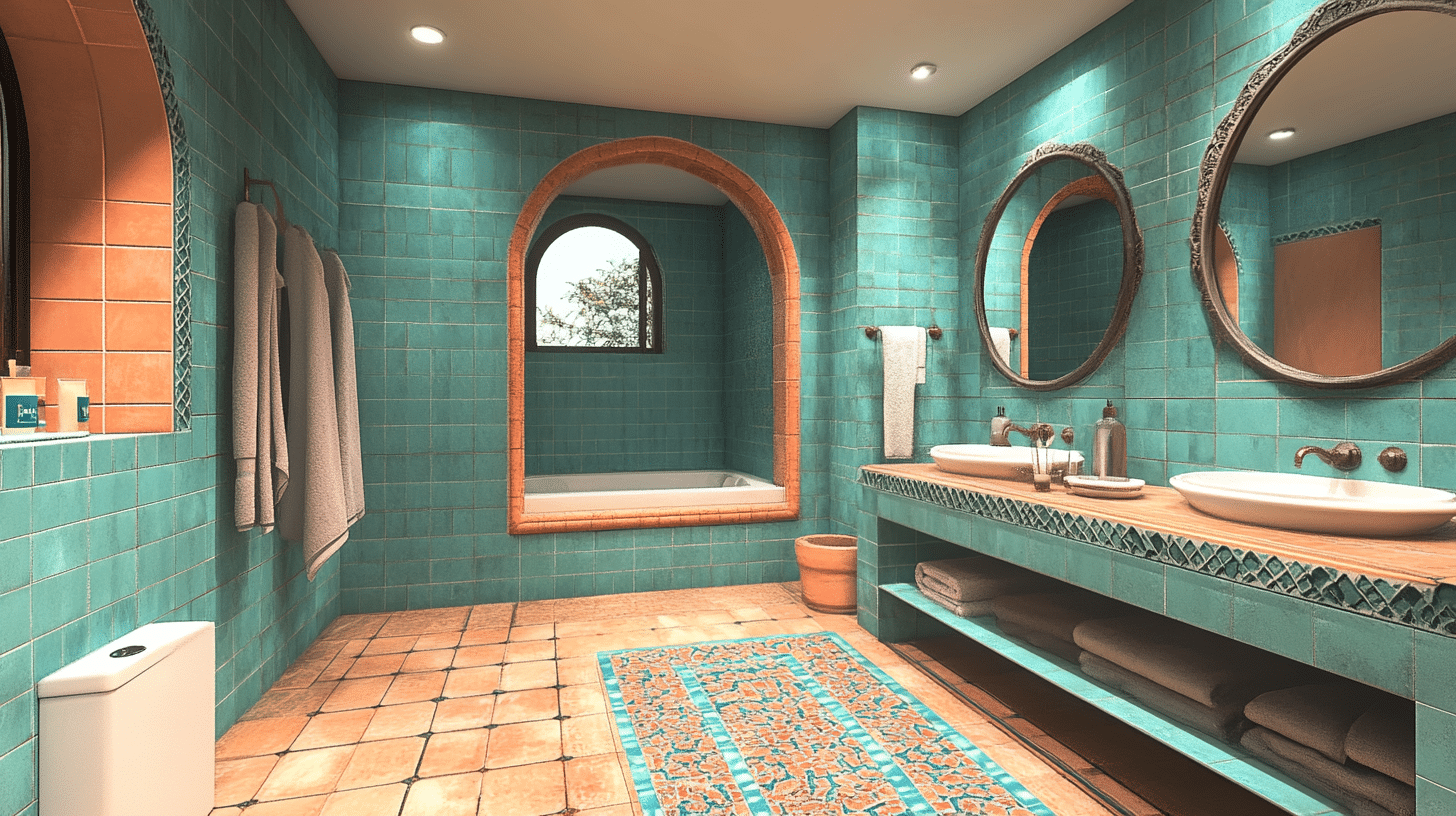
This mix reminds me of Morocco’s seaside towns. The turquoise echoes the Mediterranean, while coral nods to the warm buildings.
It’s a blend of water and earth. Try this combo in a bathroom with turquoise tiles and coral towels.
Crimson Red & Mint Green
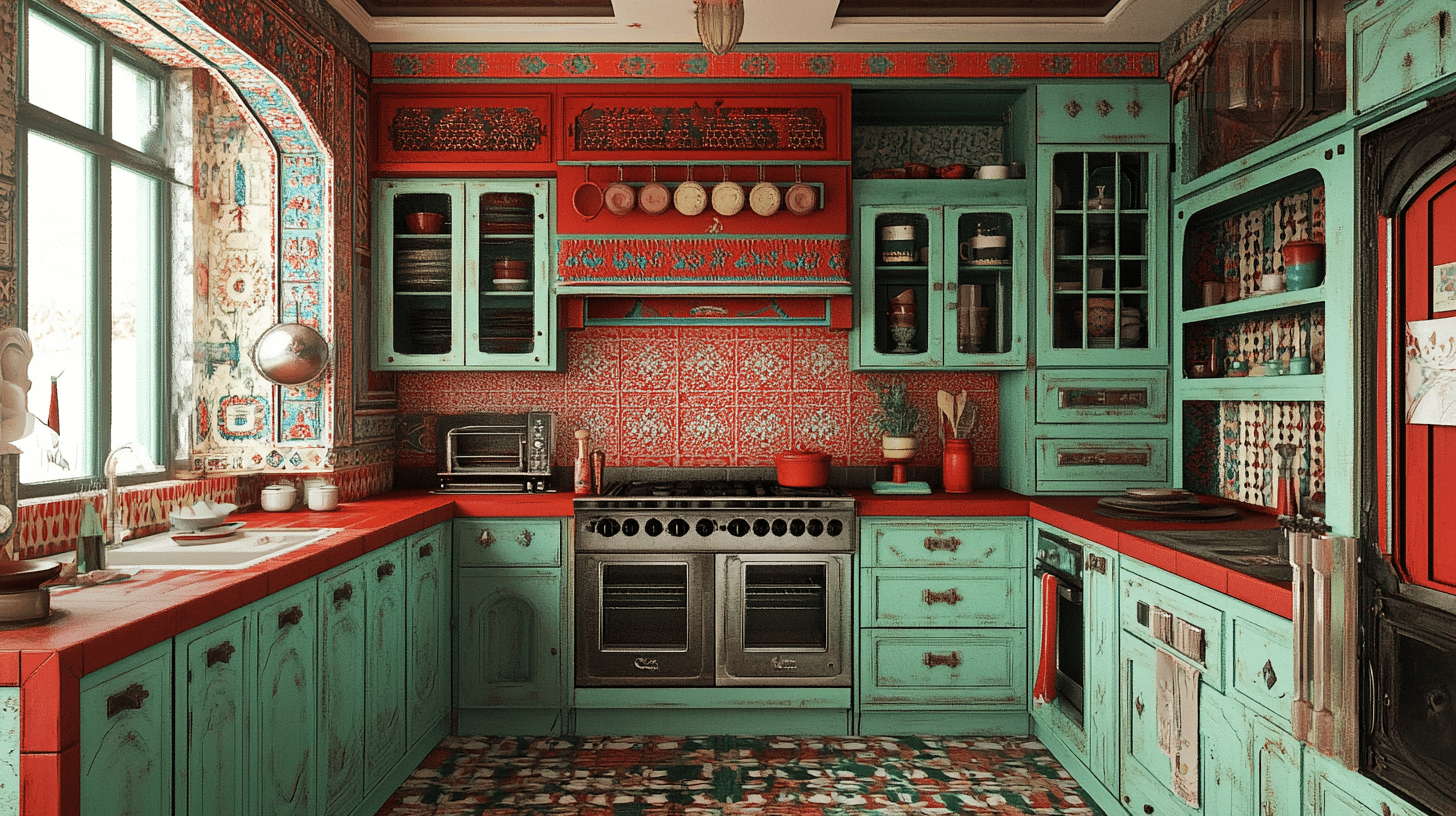
These colors recall Moroccan gardens. The red recalls the nation’s flag, while mint green represents the tea Moroccans love. It’s like stepping into a riad courtyard.
Use this pair in a kitchen with red pots and mint green backsplash.
Royal Purple & Gold
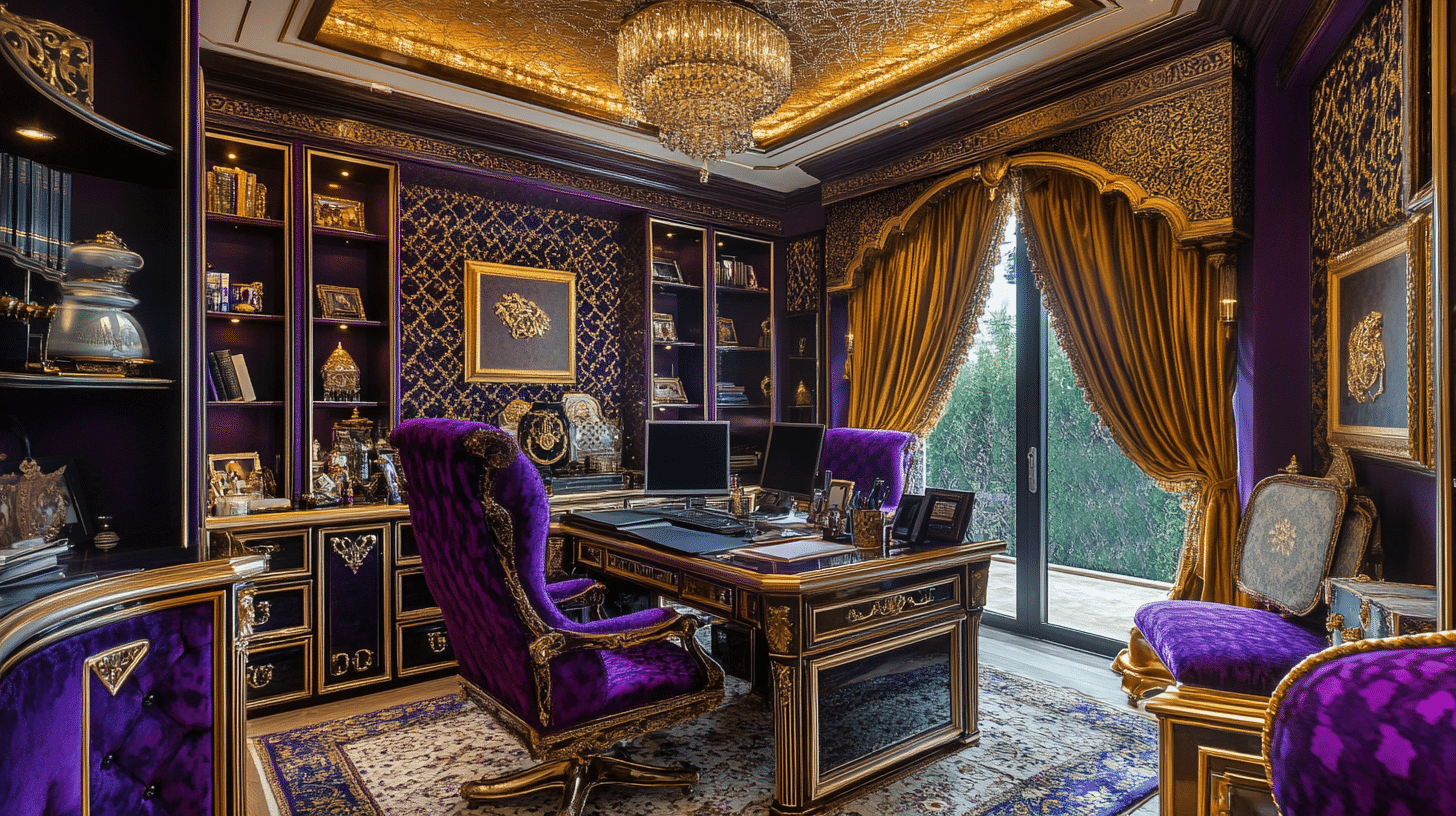
This combo screams luxury. The deep purple gives a regal feel, while gold adds a touch of glamour. It’s like a color version of a fancy palace.
Use these colors in a home office with purple walls and gold desk accessories.
Moroccan Colors in Fashion and Textiles
1. Clothing Inspiration
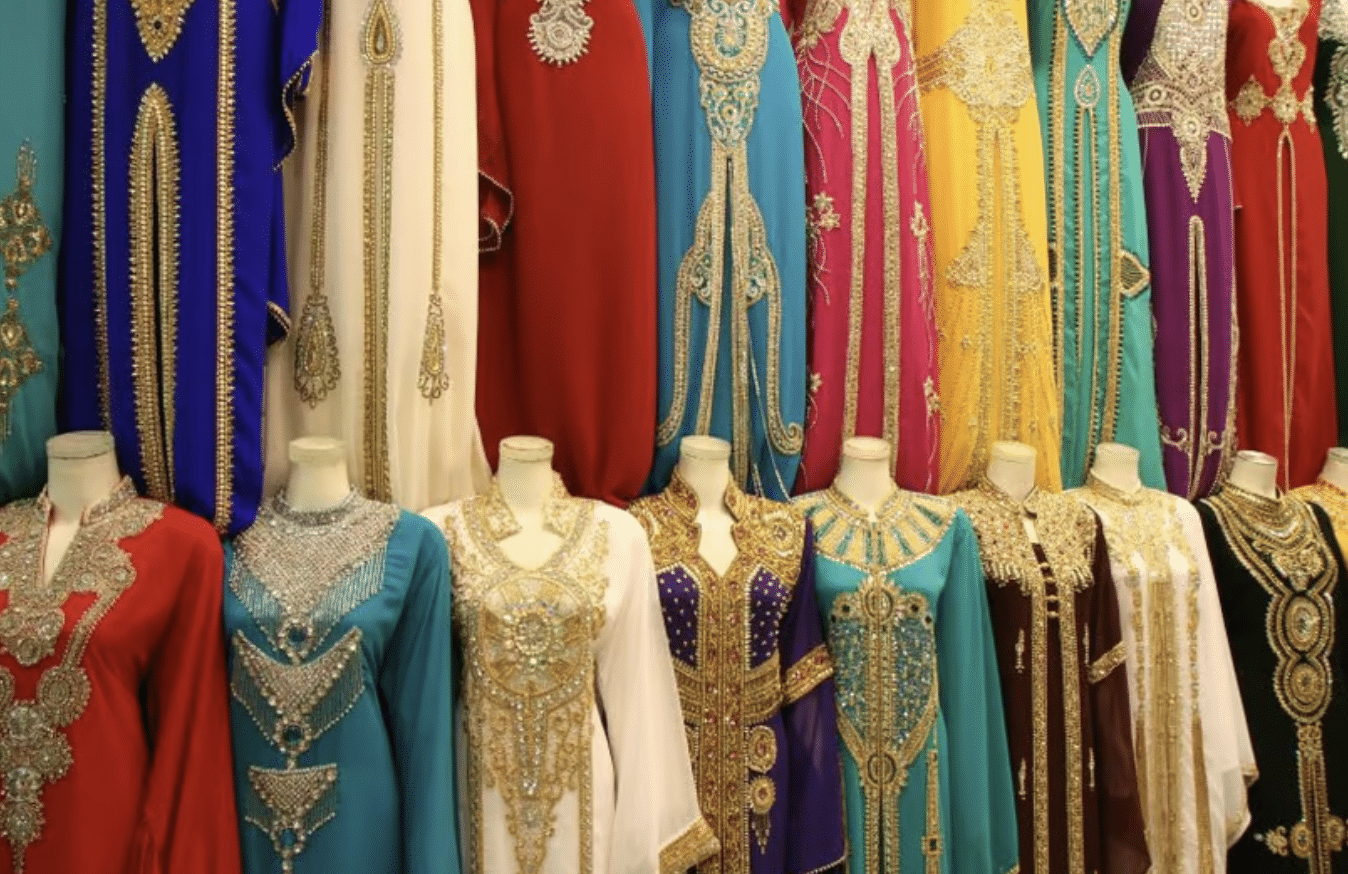
Moroccan fashion is a feast for the eyes. Traditional garments are full of meaning and color. Take the kaftan, a long, flowing robe.
It often comes in bright hues like blue, green, or red. Each color tells a story. Blue kaftans might remind you of the sea, while green ones nod to nature. Red ones? They’re all about celebration.
Another key piece is the djellaba, a hooded outfit. It’s usually in earthy tones like brown or beige. These colors link back to Morocco’s desert roots.
But for special events, you might see djellabas in richer shades like deep purple or gold.
Remember accessories! Moroccan women love colorful scarves. They mix and match bold hues to express their style. Men often wear the fez, a red hat for national pride.
2. Textile Patterns
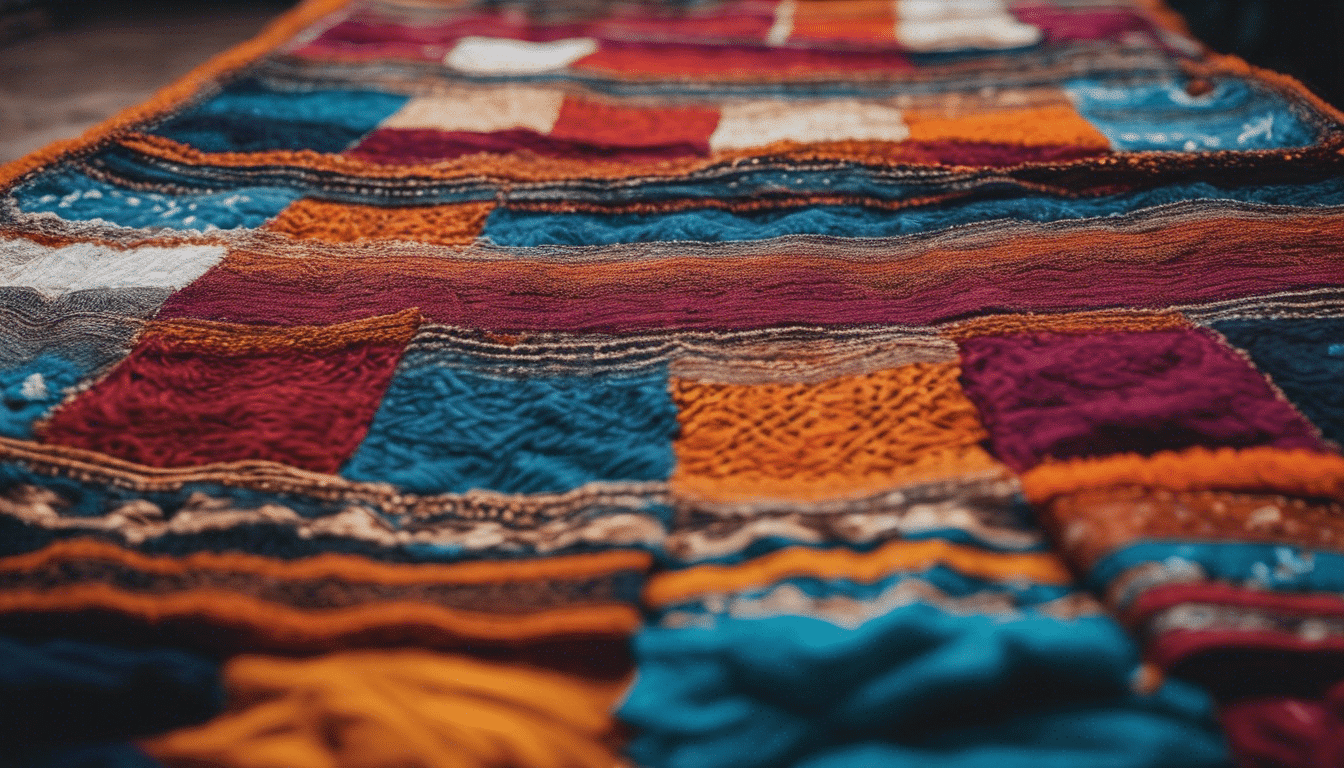
Now, let’s discuss the patterns that make Moroccan textiles so special. First up is the kilim. These flat-woven rugs are full of geometric shapes in vivid colors.
You might see zigzags in red and white or diamonds in blue and yellow. Each pattern has a meaning, often tied to nature or good luck.
Berber influences add another layer to Moroccan textiles. Berber rugs, made by indigenous people, often use natural wool colors like cream, brown, and black. But they’ll also mix in pops of bright red or orange.
Embroidery is a technique for adding tiny, colorful details to fabrics, such as gold thread on a blue background, which creates a starry night effect.
Tips for Creating an Eclectic Moroccan-Style Space
Here are some tips for creating an eclectic Moroccan-style space:
- Mix bold colors: Use a blend of warm and cool shades. Try pairing deep blues with sunny yellows or rich reds with soft greens.
- Layer patterns: Don’t be shy about mixing different designs. Combine geometric shapes with floral motifs in your rugs, pillows, and wall hangings.
- Add metallic touches: Sprinkle in some gold or silver accents. Think lamps, trays, or picture frames to add a bit of shimmer.
- Use textured fabrics: Use plush materials like velvet cushions or silk curtains to create a cozy feel.
- Incorporate low seating: Try floor cushions or a low sofa to capture that relaxed Moroccan vibe.
- Hang lanterns: Install colorful glass lanterns to cast pretty patterns on your walls.
- Display handmade items: Show off Moroccan crafts like painted ceramics or woven baskets.
- Bring in some greenery: Add potted plants or a small indoor fountain to echo Moroccan courtyard gardens.
- Use arches: If you can’t change your architecture, try an arched mirror or bookshelf to hint at Moroccan design.
- Don’t forget the details: Small touches like tassels on cushions or beaded curtain ties can make a big impact.
Wrapping It Up
As I wrap up this colorful journey through Moroccan design, I’m struck by how these vibrant hues can transform spaces and styles.
Each color tells a story, from Marrakech’s bold red to Majorelle Gardens’s soothing blue.
I want to remind you that using Moroccan colors isn’t about copying a style. It’s about bringing a bit of that magical atmosphere into your space.
Start small with a bright pillow or a patterned rug. Or go big with a feature wall in a rich, warm tone.
The beauty of Moroccan design is in its mix of colors and patterns. So don’t be afraid to experiment! Play with different combinations until you find what feels right for you.
Your space should reflect your personality with a touch of Moroccan flair.
Are you ready to add some Moroccan magic to your home?


